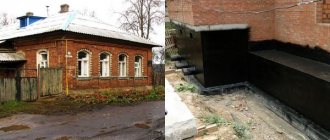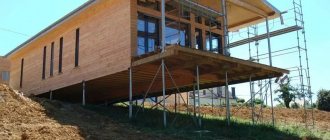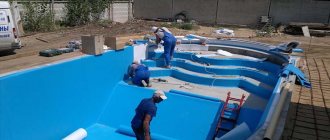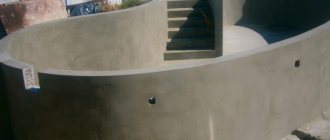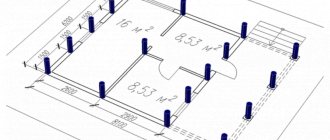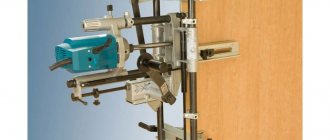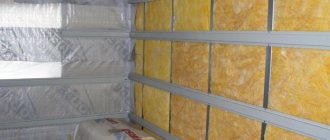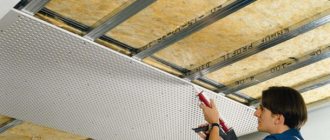A pile foundation is a supporting structure used in all situations where the bearing capacity of the soil is too low.
These include flooded areas in swampy areas, loose and unstable soils, peat bogs and other areas with problematic construction conditions.
Piles provide support on dense underlying soil layers that have appropriate parameters and are located at great depths.
The operating conditions of the supports are very complex; all possible types of loads and negative impacts are present.
One of them is close contact with soil moisture.
Is it necessary to waterproof a pile foundation?
The question of the need to waterproof a pile foundation is extremely complex.
Some experts argue that the underground part of the piles is not subject to the negative effects of moisture, since it does not have contact with atmospheric oxygen . Others note the constant negative impact of moisture, but do not see any way to combat this phenomenon, other than preliminary, at the manufacturing stage, applying protective layers to the surface or to the trunk mass.
Indeed, when immersed, all protective layers are simply erased on the ground, which makes their presence ineffective.
However, those who believe that the impact of groundwater is not too intense are also partly right..
Most problems arise from electrochemical corrosion caused by the presence of stray currents or the acidic composition of the soil.
IMPORTANT!
The surface part of the foundation creates the most problems. It is in a zone of direct contact with the atmosphere and requires measures to be taken to protect it from moisture. All waterproofing requirements that exist for any other types of supporting structures apply to it .
Types of horizontal insulation
In construction, insulation of foundations from water ingress is carried out using the following methods:
- By laying rolled roofing materials.
- Coatings with impregnating compounds.
- Injections with special water-repellent emulsions and solutions.
Roofing waterproofing material is laid directly on the upper horizontal plane of the foundation before erecting walls.
Sometimes you can hear the opinion that penetrating and injection horizontal waterproofing of foundations can be done even during the operation of the house. If, for some reason, horizontal insulation was not installed at the construction stage, then, as a way out of this situation, it is possible to treat the horizontal surface of the foundation with penetrating compounds or perform an injection waterproofing treatment.
Carrying out such processes will require significantly more time and labor, so it is best to waterproof the foundation walls immediately during the construction of the house.
Diagram of horizontal waterproofing device
Necessary materials
There are different types of waterproofing materials.
According to the type of application they are divided into:
- Superficial.
- Penetrating.
- Sprayable.
Surface materials include all traditional materials:
- Hot tar.
- Bitumen mastic.
- Ruberoid.
- Glassine.
They are easy to use and cope with their task, but some types are difficult to apply on curved or embossed surfaces with a large number of transitions or small elements.
To facilitate the insulation of concrete bases, penetrating materials are used - impregnation.
They clog the capillaries of concrete, making moisture absorption impossible. For metal parts, these materials are useless, like most exterior types.
Steel elements are best protected with sprayed materials:
- Liquid rubber.
- Liquid polyurethane foam.
These insulators are much more expensive than others and require the use of special equipment, but their efficiency is very high, and their service life, if used correctly, is comparable to the service life of the entire building .
Types of water protection
The materials used to waterproof piles come in the following varieties:
- Roll type. This is a pasting material. This includes roofing felt, technoizol, glass roofing felt, roofing felt, glassine.
- Coating type. This group is represented by mastics based on bitumen and rubber. To improve performance characteristics, various additives are added to the material. This mastic is very easy to apply. This is done with a brush.
- Sprayers. This is a modern high-tech method of waterproofing. The so-called “liquid rubber” is sprayed onto the surface and, when dried, creates a seamless water-repellent membrane around the support. This is a very wear-resistant and mechanically resistant material.
What methods exist
Waterproofing of piles depends on their design and the material used:
Drivers
They are immersed in the ground by pressing, so no surface methods are applicable here.
The issue is resolved by adding special additives to the concrete composition that prevent capillary absorption of moisture into the material. Despite this, the surface part of the foundation is subject to waterproofing using general methods .
Printed
They are installed in a well prepared in advance in various ways.
The predominant method of waterproofing is the use of waterproof formwork immersed in the well.
Plastic pipes, roofing felt or other materials are used as insulators. After pouring the concrete, the shell remains inside and protects the material from moisture.
Bored
They are one of the types of cast-in-place piles. The only difference is in the method of creating a well - drilling with the help of appropriate devices .
The waterproofing technique is no different from the methods used when working with cast-in-place piles.
Screw
The barrel material does not allow the use of polymer coatings, since during immersion they will be completely removed due to friction with the ground. The only effective way is to apply a layer of zinc that is impervious to moisture.
Many unscrupulous manufacturers make screw piles from ordinary, non-galvanized pipes.
They are coated with a layer of paint, presenting this coating as reliable protection against corrosion.
If it turns out that there is no galvanized layer, the use of such supports is prohibited.
Features and basic concepts
Concept
A grillage is a so-called horizontal platform of a pile or column base, which distributes the weight of the structure and evenly transfers its entire weight to the supports.
And they, in turn, transfer the load to the ground. In other words, its purpose is to combine piles or pillars into a solid working structure, which prevents uneven subsidence, cracking of walls, dampness, attack by various microorganisms, insects, rodents, corrosion and destruction of the room.
Thus, a well-made grillage is the key to the durability of the entire structure.
Our hero is known for the following undeniable advantages:
- security;
- versatility;
- multifunctionality;
- practicality;
- reliability;
- strength;
- wear resistance;
- durability;
- efficiency of construction;
- reducing the volume of necessary land work;
- reducing labor costs for installing the device;
- low cost;
- high stability and load-bearing capacity;
- suitability for absolutely any site;
- admissibility of use on almost any soil - sandstone, clay, and quicksand;
- the ability to create curved objects;
- reduced consumption of concrete solution (compared to “ribbon”);
- reduction of heat losses;
- reduction of vibration levels;
- the variety of raw materials intended for its creation;
- the ability to carry out construction at any time of the year, however, if the temperature is not lower than 10°C.
The design, thanks to a well-constructed grillage, will certainly delight you with its impeccable technical characteristics and charming appearance!
Annoying disadvantages
The grillage is known for the following negative “moments”:
- the need to make accurate calculations;
- the impossibility of construction on moving soil - swelling and subsidence;
- inadmissibility of use in the construction of multi-storey buildings;
- impossibility of constructing a basement;
- the need for additional insulating materials.
Waterproofing methods
The pile-strip foundation consists of two parts that perform their functions together.
Therefore, different waterproofing methods are used for each element..
For piles, the usual technology for driven supports is used - an impermeable shell is immersed, cutting off contacts with moisture for the entire service life of the shaft.
Waterproofing tape has more options:
Using hot bitumen
The surface of the concrete strip is covered with molten bitumen. Usually one or two layers are applied; in some cases, roofing material or glassine is glued onto the bitumen, thereby enhancing the insulating capabilities of the coating.
The technique requires the use of an open flame, which creates a fire hazard, especially in the summer or in windy weather.
Application of bitumen mastic
The technique was developed to eliminate the presence of open fire.
The mastic is applied with ordinary brushes and creates a dense layer of insulation.
The material is sold ready-made, which significantly speeds up work and makes it safer .
Spraying liquid rubber or polyurethane foam
Sprayed materials create an airtight and durable waterproofing film.
Its thickness depends on desire or need and can be increased to any value.
The materials are expensive and require the use of special equipment, but the efficiency and ease of application are very high.
Impregnation with various materials
Impregnations are considered one of the most effective materials that form waterproof microcrystals in concrete capillaries. The disadvantage of the material is targeted application (only for concrete or other similar types) .
NOTE!
Builders treat impregnations with distrust, caused by the external lack of application results - it is not clear from the material that a protective film has formed on the surface.
Problems in the absence of insulation
Whatever the design features of the piles, the option and technology of their installation, this type of foundation has many disadvantages:
- Cold underground, causing significant heat loss during frosts through open space.
- When the grillage is reinforced concrete, it forms a significant cold storage tank. If you do not constantly heat the room, it is not easy to restore a comfortable microclimate in it.
- Freezing of pipelines laid underground is possible.
- Piles anchored in the frost layer can be pushed out. They are an excellent conductor of cold. When insulation measures are not carried out, concrete or metal pillars become the cause of local heaving.
- If some piles are located at points with low soil density, uneven shrinkage of the building occurs.
- Aesthetically, an undecorated foundation of this type looks unattractive.
- The underground space will certainly become littered, so it has to be cleaned periodically.
Methods for waterproofing a pile-grillage foundation
The pile-grillage foundation has a design similar to the pile-tape foundation.
This is especially noticeable on foundations with a reinforced concrete grillage, which differs little from the traditional tape.
The main differences are the size and the lack of direct contact with the ground .
Wooden and metal types of grillage are a regular strapping belt that connects all piles along load lines - the locations of load-bearing internal and external walls.
Let's consider different types of waterproofing options:
Metal grillage
Sprayed or coated types of waterproofing agents are suitable for waterproofing metal parts.
The most commonly used are hot bitumen or bitumen mastic. Kuzbasslak and various polymer coatings are often used .
The application technique is similar to conventional painting, the difference is the need for maximum tightness and layer thickness.
When choosing a material, the main attention should be paid to the moisture resistance of the film, otherwise the coating will peel off from the metal surface after the first winter.
Wood
Wooden parts are not resistant to moisture. Waterproofing is carried out using special impregnations or traditional coating materials, and most builders prefer to use tar, mastics or other materials based on oils or similar compositions .
Application is done using ordinary brushes. The coating is periodically inspected, and if peeling is detected, the problem area is cleaned and touched up.
IMPORTANT!
It is not recommended to use creosote or similar materials with a strong odor, as it will constantly be present in the house.
Reinforced concrete
A reinforced concrete grillage differs little from a conventional strip foundation.
From the point of view of the waterproofing procedure, this is the same type of structure, requiring the same measures.
Considering the specifics and configuration of structural elements, the most convenient methods are the application of bitumen mastic or impregnating materials.
Applying hot bitumen is also possible, but the work is more difficult due to the need to cover the lower part of the tape, which can result in burns or other troubles. The best option is bitumen mastic, which will be most convenient to reapply later .
Calculation
To make the calculation, you need to collect all the information about the territory on which the structure is planned to be erected.
For calculations you need information about:
- physical and geographical conditions;
- geological structure;
- hydrological conditions;
- physical properties of the soil.
Based on this information:
- grillage parameters are determined;
- loads are calculated;
- the depth of placement is calculated;
- the required number of supports is determined;
- the diameter of the piles or pillars is calculated.
It is advisable to entrust this work to specialists, since the slightest mistake in calculations leads to disastrous consequences.
Which product is most optimal for piles and grillage?
The choice of the most suitable waterproofing option is determined by the design and material of the foundation.
Not all types of insulators that are suitable for wood or concrete can be used for metal parts.
At the same time, the traditional application of hot bitumen is suitable in any case, although the process itself poses a fire hazard and due to the possibility of burns.
No less convenient is bitumen mastic, which does not have the disadvantages of hot tar, but does not penetrate the material so deeply and firmly .
Sprayed materials are also suitable for all types of piles and grillages, but their price and application specifics create a significant barrier for users. The final choice is determined by the capabilities and preferences of the home owner.
Additional events
Depending on the specific geology of the site, additional waterproofing may be necessary:
- Construction of the blind area. The element can serve as a pedestrian path around the building. They dig a trench approximately 1 m wide, the bottom of which is covered with a layer of crushed stone. The hole is filled to the level of the site with any water-tight material. The blind area can also be covered with earth and sown with lawn.
- Drainage device. Trenches are dug around the perimeter of the house for drainage pipes. Water will seep through the holes in the pipes and be discharged to specially equipped places.
- Installation of a surface water drainage system (point drainage or linear channels). A layer of sand up to 20 cm is poured into the trench at a slope towards the collector, and perforated pipes are laid on top of it. The structure is covered with soil.
Waterproof painting and gluing of horizontal surfaces of concrete structures
Painted or adhesive insulation is most often used as horizontal insulation, since it can be laid with your own hands.
The thickness of the paint coating should be 5±2 mm, applied in 2–4 layers. To install insulation with your own hands, use the following types of coatings:
- Bitumen. They are produced in the form of solutions or mixtures, which, in addition to cracking, include special additives and suspensions;
- Bitumen-polymer. Can be with three types of additives: nairite resin, latex emulsion, crumb rubber;
- Polymer emulsions include mastics containing chlorobutyl rubber mixtures, alkyd, polyurethane, and epoxy additives.
Application of bitumen waterproofing by spraying
With the development of the chemical industry, the list of waterproofing paints has been supplemented with high-molecular compounds, latex cement mixtures and other materials that can be applied either manually or mechanically. Regardless of the manufacturing method, bitumen and emulsions must have sufficient adhesion - bondability with concrete: according to GOST 25591-93, the strength of the joints must be at least 1 kgf/cm2.
Isol, hydroisol, roofing felt, modified polyethylene, complex composite films and others are used as lining films for wall insulation. When choosing a material to create insulation for the base of a house with your own hands, you need to ensure that the waterproof films belong to the foundation group and not to the roofing group. Requirements for insulation design and material characteristics are set out in SNiP 3.04.03-85.
